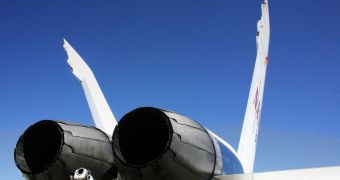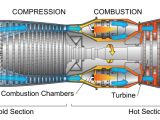Unlike traditional internal combustion engines which equip the vast majority of cars on the world's streets today, engines that convert the energy of burning fuel into direct mechanic work, jet engines generate thrust by discharging the force a fast flowing jet of fluid produces, in accordance with Newton's third law of motion, which states that a force of action must have an equal force of reaction.
Several types of jet engines have been developed over time, such as the first ever invented by Hero of Alexandria in the first century AD, which produced thrust through a pair of nozzles attached to a sphere that was spinning rapidly around its axis. The Steam-powered device actually has no practical use and is currently being considered a simple curiosity.
The first jet propulsion devices were initially fireworks invented by the Chinese civilization in the 11th century. By the early 1930s, piston internal combustion engines were still powering most of the aircrafts, but engineers soon realized that the speed of the vehicle was greatly reduced mostly due to the low efficiency of the propellers, used to convert mechanical work into thrust. In order to approach sound and higher speed, a new type of engine had to be designed.
Fortunately two decades earlier, the man who is currently considered the father of jet aviation, Romanian inventor and aerodynamics pioneer Henri Coanda, had been the first to ever equip an airplane with a revolutionary new engine basically consisting of a combination between a traditional internal combustion engine and a set of burners. The internal combustion engine was basically used to provide with compressed air for the burners, which determined a more complete burning process of the fuel to produce more thrust.
Although the compressor part of the engine was replaced with a more efficient one, the basic design of the jet engines used today remains mostly unchanged. A jet engine consists of two separate sections with completely different roles, a compressor and a combustion chamber, or, in other words, a cold section and a hot section.
The compressor is basically a turbine with multiple stages used to obtain high air pressures. The air enters the engine through a so-called intake and is fed into the turbine compressor. The compressor raises the air's pressure and introduces it into the combustion chamber, where it is mixes with fuel. Once the combustible mix is being lit, the flame is protected with the help of a flameholder that prevents the fast flowing mass of air from putting out the flame.
As a result, the burning mix produces a hot jet of fast flowing gases which are redirected towards a secondary turbine that converts part of the energy into mechanic work which will be transmitted to the compressor through a drive shaft, in order to power it. The remaining energy of the burned gases exits the back end of the engine through a nozzle in order to produce a high speed jet.
Some jet engine designs may use afterburners or reheaters that produce extra thrust by injecting fuel right into the exhaust. This power-boosting method is generally used only in critical situations, because the burn is extremely inefficient and requires high quantities of fuel. This also raises the temperature of the exhaust to dangerous levels.

 14 DAY TRIAL //
14 DAY TRIAL // 
